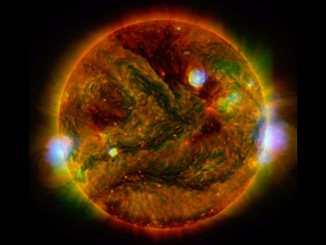
Using data from the European Space Agency’s Gaia spacecraft and its predecessor, the long-retired Hipparcos, astronomers have managed to deduce the mass of a young exoplanet for the first time, an achievement made possible by more than a quarter century of observations.
The planet in question, Beta Pictoris b, was discovered in 2008. The new estimate of its mass indicates it is a gas giant nine to 13 times more massive than Jupiter.
The Beta Pictoris system is intriguing because the star is believed to have ignited just 20 million years or so ago, giving astronomers a ringside seat for a solar system in the process of forming. But the system’s youth also makes it difficult to obtain the sort of precise measurements needed to figure out the mass of orbiting planets.
“In the Beta Pictoris system, the planet has essentially just formed,” said Ignas Snellen, an astronomer at Leiden University in the Netherlands. “Therefore we can get a picture of how planets form and how they behave in the early stages of their evolution. On the other hand, the star is very hot, rotates fast, and it pulsates.”
Those factors make it difficult to measure the radial velocity of Beta Pictoris, the subtle changes in the star’s motion as it gravitationally tugged from side to side by orbiting planets.
Those slight changes in velocity, after taking into account the star’s motion around the center of the galaxy and changes caused by measuring that motion at different times in Earth’s orbit around the Sun, can be used to figure out how massive an orbiting exoplanet must be to cause the observed wobbles.
“The star moves for different reasons,” said Ignas. “First, the star circles around the centre of the Milky Way, just as the Sun does. That appears from the Earth as a linear motion projected on the sky. We call it proper motion. And then there is the parallax effect, which is caused by the Earth orbiting around the Sun. Because of this, over the year, we see the star from slightly different angles.”

The minuscule wobbles caused by the presence of one or more planets orbiting a target star cause changes in motion in the plane of the sky, not along the line of sight.
“We are looking at the deviation from what you expect if there was no planet and then we measure the mass of the planet from the significance of this deviation,” said Leiden astronomer Anthony Brown. “The more massive the planet, the more significant the deviation.”
But to determine the mass of an exoplanet, astronomers need many years of data to separate the effects of parallax and proper motion. The Gaia satellite made about 30 high-precision observations of Beta Pictoris during the 22 months of observations that went into the spacecraft’s second data release. But that was not enough.
So Snellen and Brown turned to archived data from the Hipparcos satellite, which made 111 such observations between 1990 and 1993.
“By combining data from Hipparcos and Gaia, which have a time difference of about 25 years, you get a very long-term proper motion,” says Brown. “This proper motion also contains the component caused by the orbiting planet. Hipparcos on its own would not have been able to find this planet because it would look like a perfectly normal single star unless we had measured it for a much longer time.
“Now, by combining Gaia and Hipparcos and looking at the difference in the long term and the short term proper motion, we can see the effect of the planet on the star.”



